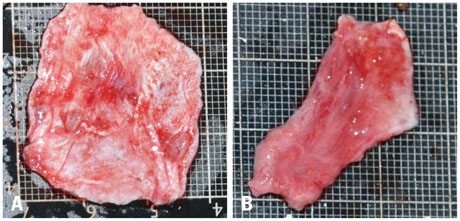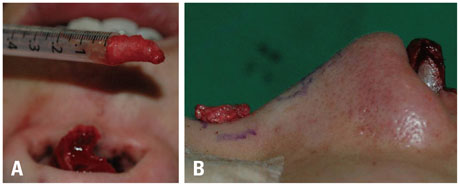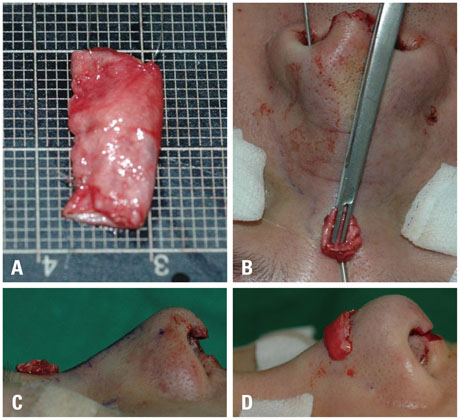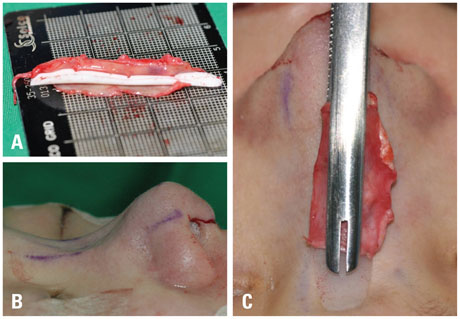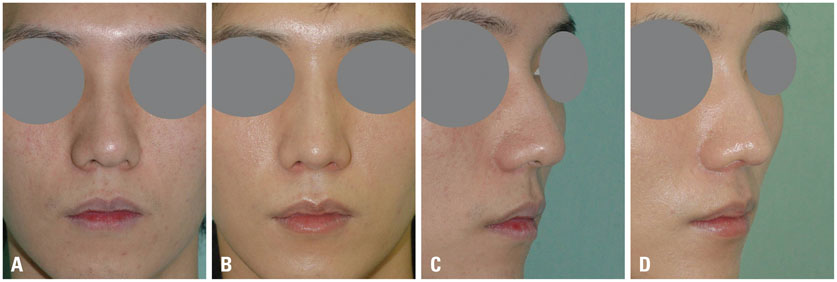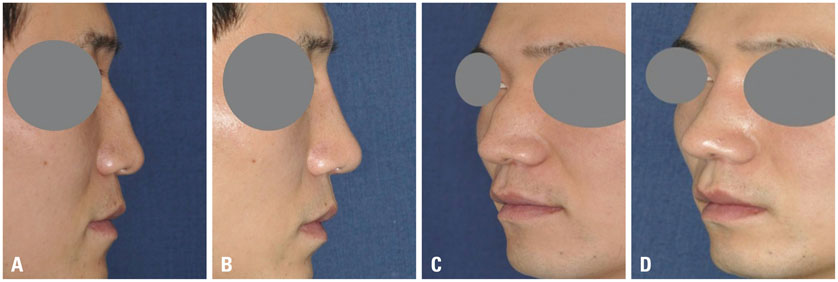Yonsei Med J.
2015 Jan;56(1):167-174. 10.3349/ymj.2015.56.1.167.
Various Applications of Deep Temporal Fascia in Rhinoplasty
- Affiliations
-
- 1April31 Aesthetic Plastic Surgery Clinic, Seoul, Korea. april31psw@gmail.com
- 2Department of Plastic and Reconstructive Surgery, Soonchunhyang University College of Medicine, Seoul, Korea.
- KMID: 2352803
- DOI: http://doi.org/10.3349/ymj.2015.56.1.167
Abstract
- PURPOSE
In Asians, nasal dorsal and tip augmentation procedures are usually performed at the same time, and most dorsal augmentations use implants. In this study, dorsal augmentation was given by various types of grafts using deep temporal fascia (DTF) for primary rhinoplasty cases using only autologous tissues to improve the curve of hump noses and depressions. For secondary rhinoplasty cases, DTF was used to improve implant demarcation and transparency. Such effectiveness and utility of DTF is discussed.
MATERIALS AND METHODS
Between May 2009 and May 2012, we performed rhinoplasty using DTF in 175 patients, which included 78 secondary surgery patients and 128 female patients. The mean age of the patients was 31.4. DTF was utilized with various types of grafts without implants to improve the curve in dorsal augmentation of hump noses and cases that required curve betterment. DTF was used to improve implant demarcation and transparency for secondary cases.
RESULTS
The mean follow-up duration was 1.5 years. Of the 175 patients, 81% were satisfied with the natural correction achieved, whereas 19% complained of undercorrection, which was resolved with additional surgery. No specific complications such as nasal inflammation or contractures were observed.
CONCLUSION
DTF can be used with various graft methods for correction of radix, dorsal, and tip irregularities. It can also be used to correct implant contour transparency in secondary rhinoplasty and thus may be considered as a useful supplementary graft material in rhinoplasty for Asians.
Keyword
MeSH Terms
Figure
Reference
-
1. Aum JH, Kang DH, Oh SA, Gu JH. Orthodromic transfer of the temporalis muscle in incomplete facial nerve palsy. Arch Plast Surg. 2013; 40:348–352.2. Jeong W, Son D, Yeo H, Jeong H, Kim J, Han K, et al. Anatomical and functional recovery of neurotized remnant rectus abdominis muscle in muscle-sparing pedicled transverse rectus abdominis musculocutaneous flap. Arch Plast Surg. 2013; 40:359–366.
Article3. Kang MJ, Chung CH, Chang YJ, Kim KH. Reconstruction of the lower extremity using free flaps. Arch Plast Surg. 2013; 40:575–583.
Article4. Kua EH, Leo KW, Ong YS, Cheng C, Tan BK. Vascularisation of urethral repairs with the gracilis muscle flap. Arch Plast Surg. 2013; 40:584–588.
Article5. Yoon SH, Burm JS, Yang WY, Kang SY. Vascularized bipedicled pericranial flaps for reconstruction of chronic scalp ulcer occurring after cranioplasty. Arch Plast Surg. 2013; 40:341–347.
Article6. Zayakova Y, Stanev A, Mihailov H, Pashaliev N. Application of local axial flaps to scalp reconstruction. Arch Plast Surg. 2013; 40:564–569.
Article7. Kim JH, Oh WS, Park SW, Kim KH. Various surgical procedures in the scale of upturned nose. J Korean Soc Aesthetic Plast Surg. 2010; 16:21–34.8. Smith RA. The free fascial scalp flap. Plast Reconstr Surg. 1980; 66:204–209.
Article9. Brent B, Byrd HS. Secondary ear reconstruction with cartilage grafts covered by axial, random, and free flaps of temporoparietal fascia. Plast Reconstr Surg. 1983; 72:141–152.10. Abul-Hassan HS, von Drasek Ascher G, Acland RD. Surgical anatomy and blood supply of the fascial layers of the temporal region. Plast Reconstr Surg. 1986; 77:17–28.11. Besharatizadeh R, Ozkan BT, Tabrizi R. Complete or a partial sheet of deep temporal fascial graft as a radix graft for radix augmentation. Eur Arch Otorhinolaryngol. 2011; 268:1449–1453.
Article12. Harel M, Margulis A. Dorsal augmentation with diced cartilage enclosed with temporal fascia in secondary endonasal rhinoplasty. Aesthet Surg J. 2013; 33:809–816.13. Guerrerosantos J. Temporoparietal free fascia grafts in rhinoplasty. Plast Reconstr Surg. 1984; 74:465–475.
Article14. Lee KC, Ha SU, Park JM, Kim SK, Park SH, Kim JH. Foreign body removal and immediate nasal reconstruction with superficial temporal fascia. Aesthetic Plast Surg. 2006; 30:351–355.
Article15. Han K, Yeo HJ, Choi TH, Kim J, Son D. Rhinoplasty using various autogenous tissues. J Korean Soc Plast Reconstr Surg. 2010; 37:37–45.16. Calvert J, Brenner K. Autogenous dorsal reconstruction: maximizing the utility of diced cartilage and fascia. Semin Plast Surg. 2008; 22:110–119.
Article17. Son D, Kwak M, Yun S, Yeo H, Kim J, Han K. Large auricular chondrocutaneous composite graft for nasal alar and columellar reconstruction. Arch Plast Surg. 2012; 39:323–328.
Article18. Dhong ES, Kim YJ, Suh MK. L-shaped columellar strut in East asian nasal tip plasty. Arch Plast Surg. 2013; 40:616–620.
Article19. Kim JH, Park SW, Oh WS, Lee JH. New classification for correction of alar retraction using the alar spreader graft. Aesthetic Plast Surg. 2012; 36:832–841.
Article20. Dubay DA, Wang X, Kirk S, Adamson B, Robson MC, Franz MG. Fascial fibroblast kinetic activity is increased during abdominal wall repair compared to dermal fibroblasts. Wound Repair Regen. 2004; 12:539–545.
Article21. Walter AJ, Morse AN, Leslie KO, Hentz JG, Cornella JL. Histologic evaluation of human cadaveric fascia lata in a rabbit vagina model. Int Urogynecol J Pelvic Floor Dysfunct. 2006; 17:136–142.
Article22. Kelly MH, Bulstrode NW, Waterhouse N. Versatility of diced cartilage-fascia grafts in dorsal nasal augmentation. Plast Reconstr Surg. 2007; 120:1654–1659.
Article23. Daniel RK. Diced cartilage grafts in rhinoplasty surgery: current techniques and applications. Plast Reconstr Surg. 2008; 122:1883–1891.
Article24. Calvert JW, Brenner K, DaCosta-Iyer M, Evans GR, Daniel RK. Histological analysis of human diced cartilage grafts. Plast Reconstr Surg. 2006; 118:230–236.
Article25. Arslan E, Majka C, Polat A. The fate of diced cartilage grafts of traumatized versus nontraumatized origin. Aesthetic Plast Surg. 2007; 31:365–371.
Article26. Kim YH, Kim JT. Nasal reconstruction with double-layer tensor fascia lata-wrapped diced rib cartilage in a patient with severe dorsal collapse. J Craniofac Surg. 2011; 22:628–630.
Article27. Tasman AJ. Advances in nasal dorsal augmentation with diced cartilage. Curr Opin Otolaryngol Head Neck Surg. 2013; 21:365–371.
Article28. McCurdy JA, Lam SM. Cosmetic surgery of the Asian face. 2nd ed. New York: Thieme;2005.29. Kim JG, Rhee SC, Cho PD, Kim DJ, Lee SH. Absorbable plate as a perpendicular strut for acute saddle nose deformities. Arch Plast Surg. 2012; 39:113–117.
Article30. Kim JN, Choi HG, Kim SH, Park HJ, Shin DH, Jo DI, et al. The efficacy of bioabsorbable mesh as an internal splint in primary septoplasty. Arch Plast Surg. 2012; 39:561–564.
Article31. Cakmak O, Bircan S, Buyuklu F, Tuncer I, Dal T, Ozluoglu LN. Viability of crushed and diced cartilage grafts: a study in rabbits. Arch Facial Plast Surg. 2005; 7:21–26.32. Erol OO. The Turkish delight: a pliable graft for rhinoplasty. Plast Reconstr Surg. 2000; 105:2229–2241.
Article33. Gryskiewicz JM. Waste not, want not: the use of AlloDerm in secondary rhinoplasty. Plast Reconstr Surg. 2005; 116:1999–2004.
Article34. Lee JH, Park KR, Kim TG, Ha JH, Chung KJ, Kim YH, et al. A comparative study of CG CryoDerm and AlloDerm in direct-to-implant immediate breast reconstruction. Arch Plast Surg. 2013; 40:374–379.
Article
- Full Text Links
- Actions
-
Cited
- CITED
-
- Close
- Share
- Similar articles
-
- A Case of Infection of Tutoplast-Processed Fascia Lata in Augmentation Rhinoplasty
- Cadaveric study of deep temporal fascia for autologous rhinoplasty grafts: Dimensions of the temporal compartment in Asians
- Spacer graft using deep temporal fascia in the treatment of paralytic ectropion
- Correction of "low-set"ear with fascia lata
- Secondary Rhinoplasty Using Scarpa's Fascia


